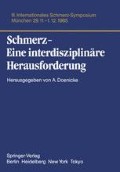Zusammenfassung
“Viele Patienten verbinden mit der Diagnose Krebs neben der Unheilbarkeit vor allem den Schmerz, von dem sie nur der qualvolle Tod erlösen kann”[15]. Diese Ängste sind infolge einer weit verbreiteten inadäquaten Schmerztherapie nicht unbegründet.
Access this chapter
Tax calculation will be finalised at checkout
Purchases are for personal use only
Preview
Unable to display preview. Download preview PDF.
Literatur
Ball M, McQuay HJ, Moore RA, Allen MC, Fisher A, Sear J (1985) Renal failure and the use of morphine in intensive care. Lancet ii: 784
Bigler D, Eriksen J, Christensen CB (1984) Prolonged respiratory depression caused by slow release morphine. Lancet ii: 1477
Bonica JJ (1981) Cancer pain. In: Klastersky R, Staquet N (eds): Medical complications in cancer patients. Raven Press, New York
Garret ER, Jackson AJ (1979) Pharmacokinetics of morphine and its surrogates. J Pharm Sei 68: 753
McQuay H, Moore A (1984) Be aware of renal function when prescribing morphine. Lancet ii: 284
Moore A, Sear J, Baldwin D, Allen M, Hunniset A, Bullingham R, McQuay H (1984) Morphine kinetics during and after renal transplantation. Clin Pharmacol Ther 35: 641
Mount BM, Ajemian J, Scott JF (1976) Use of the Brompton Mixture in treating chronic pain in the malignant disease. Can Med Ass 115: 122
Koßmann B, Bowdler I, Ahnefeld FW (1984) Die Komplexizität der Schmerztherapie am Beispiel des Karzinompatienten. In: Bergmann H, Bischko J, Gerstenbrand F, Klingler D, Steinbereithner K, Tilscher H (Hrsg) Moderne Schmerzbehandlung. Maudrich, Wien München Berlin
Ko$mann B, Bowdler I, Ahnefeld FW (1985) Schmerzambulanz - Behand-lungserfahrungen mit herkömmlichen Methoden. In: Just OH, Wiedemann K (Hrsg) Die anaesthesiologische Poliklinik - Anaesthesieambulanz, Ambulanznarkose, Schmerzambulanz. Thieme, Stuttgart New York
Koßmann B, Dick W, Bowdler I, Kilian J, Hecht M (1984) Modern aspects of morphine therapy. In: Wilkes E, Levy J (eds) Advances in morphine therapy. Royal Society of Medicine, London
Pannuti F, Rossi AP, Vecchi F (1982) Control of chronic pain in very advanced cancer patients with morphine hydrochloride administered by oral, rectal and sublingual route. Pharmacol Res Commun 14: 369
Rane A, Säwe J, Dahlström B, Paalzow L, Kager L (1982) Pharmacological treatment of cancer pain with special reference to the oral use of morphine. Acta Anaesthesiol Scand (Suppl) 74: 97
Regnard CFB,Twycross RG (1984) Metabolism of narcotics. Lancet i: 860
Säwe J, Dahlström B, Paalzow L, Rane A (1981) Morphine kinetics in cancer patients. Clin Pharmacol Ther 30: 629
Schlegel G (1982) Die Therapie des Tumorschmerzes. Tumor Diagnostik Therapie 1: 10
Schreml W, Hugl W, Koßmann B, Heimpel H (1983) Stufenplan der analgetischen Therapie bei Tumorpatienten - eine prospektive Studie. Tumor Diagnostik Therapie 4: 189
Twycross RG (1974) Clinical experience with diamorphine in advanced malignant disease. Int J Clin Pharmacol 2: 184
Twycross RG (1982) Morphine and diamorphine in the terminally ill patient. Acta Anaesthesiol Scand (Suppl) 74: 128
Twycross RG, Wald SJ (1976) Long term use of diamorphine in advanced cancer. In:Bonica JJ, Albe-Fessard D (eds) Advances in pain research and therapy. Raven Press, New York Vol 1 1
Twycross RG, Zenz M (1983) Die Anwendung von oralem Morphin bei inkurablen Schmerzen. Anaesthesist 32: 279
Walsh TD, Baxter R, Bowman K, Leber B (1981) High dose morphine and respiratory function in chronic cancer pain. Pain (Suppl) 1: 39
Way EL, Adler TK (1962) The biological disposition of morphine and its surrogates. Bulletin World Health Organisation Geneva 79
Wörz R (1982) Die medikamentöse Linderung von Karzinomschmerz. MMW 40: 855
Editor information
Editors and Affiliations
Rights and permissions
Copyright information
© 1986 Springer-Verlag, Berlin Heidelberg
About this paper
Cite this paper
Koßmann, B., Bowdler, I. (1986). Erfahrungen mit MST bei Karzinompatienten. In: Doenicke, A. (eds) Schmerz- Eine interdisziplinäre Herausforderung. Springer, Berlin, Heidelberg. https://doi.org/10.1007/978-3-642-93322-6_9
Download citation
DOI: https://doi.org/10.1007/978-3-642-93322-6_9
Publisher Name: Springer, Berlin, Heidelberg
Print ISBN: 978-3-540-16603-0
Online ISBN: 978-3-642-93322-6
eBook Packages: Springer Book Archive

